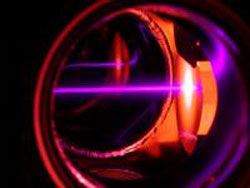Laser trapping of erbium may lead to novel devices

A purple laser beam slows erbium atoms (the purple beam traveling right to left) emerging from an oven at 1300 degrees C, in preparation for trapping and cooling. The unusual properties of erbium atoms and the new capability to trap them could lead to development of novel technologies. Credit: Credit: NIST
Physicists at the National Institute of Standards and Technology (NIST) have used lasers to cool and trap erbium atoms, a “rare earth” heavy metal with unusual optical, electronic and magnetic properties. The element has such a complex energy structure that it was previously considered too wild to trap. The demonstration, reported in the April 14 issue of Physical Review Letters,* might lead to the development of novel nanoscale devices for telecommunications, quantum computing or fine-tuning the properties of semiconductors.
Laser cooling and trapping involves hitting atoms with laser beams of just the right color and configuration to cause the atoms to absorb and emit light in a way that leads to controlled loss of momentum and heat, ultimately producing a stable, nearly motionless state. Until now, the process has been possible only with atoms that switch easily between two energy levels without any possible stops in between. Erbium has over 110 energy levels between the two used in laser cooling, and thus has many ways to get “lost” in the process. NIST researchers discovered that these lost atoms actually get recycled, so trapping is possible after all.
The NIST team heated erbium to over 1300 degrees C to make a stream of atoms. Magnetic fields and six counter-propagating purple laser beams were then used to cool and trap over a million atoms in a space about 100 micrometers in diameter. As the atoms spend time in the trap, they fall into one or more of the 110 energy levels, stop responding to the lasers, and begin to diffuse out of the trap. Recycling occurs, though, because the atoms are sufficiently magnetic to be held in the vicinity by the trap’s magnetic field. Eventually, many of the lurking atoms fall back to the lowest energy level that resonates with the laser light and are recaptured in the trap.
The erbium atoms can be trapped at a density that is high enough to be a good starting point for making a Bose-Einstein condensate, an unusual, very uniform state of matter used in NIST research on quantum computing. Cold trapped erbium also might be useful for producing single photons, the smallest particles of light, at wavelengths used in telecommunications. In addition, trapped erbium atoms might be used for “doping” semiconductors with small amounts of impurities to tailor their properties. Erbium–which, like other rare earth metals, retains its unique optical characteristics even when mixed with other materials–is already used in lasers, amplifiers and glazes for glasses and ceramics. Erbium salts, for example, emit pastel pink light.
Media Contact
More Information:
http://www.nist.govAll latest news from the category: Physics and Astronomy
This area deals with the fundamental laws and building blocks of nature and how they interact, the properties and the behavior of matter, and research into space and time and their structures.
innovations-report provides in-depth reports and articles on subjects such as astrophysics, laser technologies, nuclear, quantum, particle and solid-state physics, nanotechnologies, planetary research and findings (Mars, Venus) and developments related to the Hubble Telescope.
Newest articles

Properties of new materials for microchips
… can now be measured well. Reseachers of Delft University of Technology demonstrated measuring performance properties of ultrathin silicon membranes. Making ever smaller and more powerful chips requires new ultrathin…

Floating solar’s potential
… to support sustainable development by addressing climate, water, and energy goals holistically. A new study published this week in Nature Energy raises the potential for floating solar photovoltaics (FPV)…

Skyrmions move at record speeds
… a step towards the computing of the future. An international research team led by scientists from the CNRS1 has discovered that the magnetic nanobubbles2 known as skyrmions can be…





















